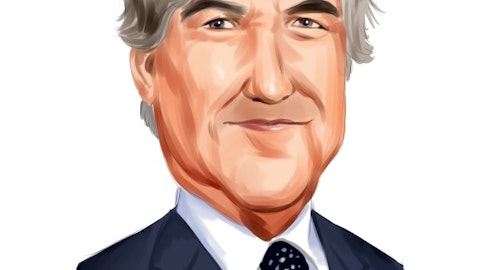Capital One Financial Corp. (NYSE:COF) is well-known as one of the leading credit-card issuers in the world, and for good reason. I carry three credit cards in my wallet, all of which have become Capital One cards as a result of their acquisitions of ING and HBSC over the past year or so. So much for variety…
However, what a lot of investors don’t seem to realize is that credit card receivables only account for 44% of Capital One Financial Corp. (NYSE:COF)’s loan portfolio. The rest of their lending business is in the form of home loans (21%), auto loans (13%), retail banking loans (2%) and commercial loans (19% – mostly commercial real estate). With consumers remaining reluctant to take on debt, given the financial turmoil of the past 5 years or so, why would anyone want to get involved with a major lender like Capital One?
About Capital One

Capital One’s business is divided into three segments. The Credit Card segment includes all of Capital One’s domestic and international credit card lending, and it has significantly expanded recently. The acquisition of ING last February and the resulting increase in banking deposits allowed the company to acquire HBSC’s U.S. credit card portfolio which consisted of around $27.6 billion in receivables. HBSC issued credit cards for many retailers and other financial institutions, to name a few, before the acquisition I had an HBSC-issued Discover card, as well as a Best Buy rewards card, both of which are now Capital One Financial Corp. (NYSE:COF) credit cards.
Capital One is the number five credit card issuer in the U.S., based on purchase volume, which totaled around $148 billion in 2012, including HBSC’s business. The company competes with direct issuers such as American Express Company (NYSE:AXP) which is the number one overall and Discover Financial Services (NYSE:DFS), the number six issuer, as well as with private issuers such as Chase Corporation (NYSEAMEX:CCF) the number two issuer and Bank of America Corp (NYSE:BAC), the number three. Before I get into a discussion about the competition, I should briefly mention Capital One’s other two segments.
The remainder of Capital One’s business is made up of the Commercial Banking and Consumer Banking segments, which include the company’s branch-based lending and deposit gathering businesses. It also includes Capital One 360, which is what ING Direct became, and is still marketed as a branchless direct bank. This gives Capital One Financial Corp. (NYSE:COF) a distinct advantage over other banks, with less overhead that comes with physical banking locations.
Competitors
As mentioned before, American Express Company (NYSE:AXP) is the largest card issuer in the country by a considerable margin, with $519.5 billion in purchase volume. I love American Express as a company, with an excellent business model of attracting creditworthy consumers by offering a range of credit and charge cards that appeal to specific groups of consumers. However, as an investment I am a bit cautious right now. The company’s stock has risen over 15% since the first of the year, and seems to be making new 52-week highs every day now. This may be a bit overblown, as the company is now trading at around 17 times TTM earnings, well over their historical average of around 14. I would need a significant pullback before considering an investment in American Express Company (NYSE:AXP).
Discover is in the same boat, even more than American Express perhaps, as their chart is starting to look parabolic lately. Up over 15% in the past three weeks alone, I think it may be time for Discover shareholders to be cautious, or maybe even take profits. I wrote about Discover about two weeks ago, however with the spike in share price, the fundamentals have changed considerably in that short time. My thesis is still valid, and I love Discover long-term. I’m especially curious to see how their PayPal deal plays out. However, at this point I would wait for the price to correct itself a bit. For those who took my advice and invested in Discover a couple weeks ago, you may want to consider taking at least some of your profits off the table.
Finally, just a few brief comments about the non-direct issuers Chase and Bank of America, which mainly issue Visa and MasterCard credit cards. Chase is a division of JP Morgan, which is by far my favorite overall financial company. I also wrote about JP Morgan recently, which even at its 52-week high, I still feel it is undervalued. Their acquisitions during and after the financial crisis have made them such a strong and well-rounded company.
Bank of America, on the other hand, has come too far too fast. I am yet to hear a solid argument that justifies their almost doubled stock price over the past year. Until they develop a track record of earnings growth, and above all, stability, I cannot advocate Bank of America as anything but a speculative investment at this point.
So Why Capital One?
With great alternatives, such as those mentioned above, why choose Capital One? The short answer is that it is the one that is still cheap. At just 8.8 times earnings, and with a 9% projected forward growth rate, Capital One is too attractive to ignore. Shares are still over 12% below their 52-week high, even after the market has continued making new highs.
I love Capital One because of its aggressive growth and for the nature of that growth. ING especially was a great move for the company, as it increased Capital One’s deposits by over 75% and creates myriad possibilities for expansion going forward.
The article With Most Financials Skyrocketing, Here’s One That’s Still Worth A Look originally appeared on Fool.com and is written by Matthew Frankel.
Copyright © 1995 – 2013 The Motley Fool, LLC. All rights reserved. The Motley Fool has a disclosure policy.

